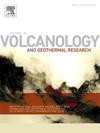Development of the Late Oligocene Zákupy Diatreme, Czech Republic: New insights into protracted diatreme emplacement
IF 2.4
3区 地球科学
Q2 GEOSCIENCES, MULTIDISCIPLINARY
Journal of Volcanology and Geothermal Research
Pub Date : 2025-02-01
DOI:10.1016/j.jvolgeores.2024.108257
引用次数: 0
Abstract
The Zákupy diatreme is well exposed by an abandoned quarry on Kamenický Vrch Hill (Czech Republic) located in the Lusatian (Lausitz) Volcanic Field in the eastern part of the NE-SW trending Ohře Rift. The abandoned quarry's walls extend upward over 50 m exposing the lower and upper diatreme facies. Petrographic analyses revealed two main compositionally distinct suites of intrusive and extrusive bodies: dikes, sills, and lava-lakes with relics of fine-grained basanite (to limburgite) and a set of rhönite-bearing picrobasalt dikes and sills. The parallel, almost linear, and relatively fractionated (LaN/YbN 21.98–26.21) chondrite-normalized REE patterns suggest the erupted magmas originated through low-degree partial melting and did not undergo any significant fractionation. Close relationships between basanites and picrobasalts is confirmed also with mineral chemistry with almost identical compositional trends of clinopyroxene and spinel-group phases. The negligible difference between bulk-rock Mg# (0.71–0.72 for basanites and 0.74 for picrobasalts) and melt Mg# calculated from olivine composition (0.70 for basanites and 0.68–0.70 for picrobasalts) reflects rather a load of mantle-derived (high Mg#) xenoliths and xenocrysts rather than the presence of cummulitic olivine. Anisotropy of magnetic susceptibility data reveals magnetic fabrics of variable orientations that reflect upward, downward, and subhorizontal magma flow within the diatreme complex. Paleomagnetic data fall into three general groupings that we interpret to reflect magma emplacement during at least three phases. These data also support tilting, rotation, and slumping of diatreme host rocks causing physical displacement of the intrusions following remanence acquisition. Four new 40Ar/39Ar age determinations from the picrite (n = 1) and basinite (n = 3) yield relatively undisturbed age spectra that constrain the age of emplacement between 31.24 and 32.40 Ma, indicating that magmatic evolution of the Zákupy diatreme spanned 1.2 million years. This multidisciplinary study reveals that the Zákupy diatreme evolved from several similarly sourced magmatic pulses. Repeated molten fuel coolant interactions produced a complex diatreme setting consisting of multiple eruptive events leading to coherent intrusions, various pyroclastic and hyaloclastite materials, local contact metamorphism, and other evidence of explosive hot rock-fluid interactions. The complex evolution and eruptive behavior, together with a protracted time of the diatreme activity, illuminate that small, seemingly simple volcanoes experience a very dynamic evolution involving multiple intrusive events, changing eruptive styles, and surface morphologies.
捷克共和国晚渐新世Zákupy双atreme的发展:对长时间双atreme就位的新认识
Zákupy裂谷被一个废弃的采石场很好地暴露在Kamenický Vrch山(捷克共和国)上,该山位于东北-西南走向Ohře裂谷东部的Lusatian (Lausitz)火山场。废弃采石场的墙壁向上延伸超过50米,暴露出下部和上部的地层相。岩石学分析揭示了两套主要组成不同的侵入体和挤出体:岩脉、岩壁和带有细粒玄武岩(至林布尔岩)遗迹的熔岩湖,以及一套rhönite-bearing微玄武岩岩脉和岩壁。平行、近线性、相对分异(LaN/YbN 21.98 ~ 26.21)的球粒陨石归一化稀土元素模式表明喷发岩浆起源于低程度部分熔融,未发生明显分异。玄武岩与微玄武岩的密切关系也被矿物化学证实,斜辉石和尖晶石群相的组成趋势几乎相同。大块岩石的mg#(玄武岩为0.71-0.72,微玄武岩为0.74)与根据橄榄石组成计算的熔体mg#(玄武岩为0.70,微玄武岩为0.68-0.70)之间的差异可以忽略不计,这反映了地幔源(高mg#)包体和外晶的大量存在,而不是多粒橄榄石的存在。磁化率数据的各向异性揭示了可变方向的磁结构,这些磁结构反映了岩浆岩内向上、向下和亚水平的岩浆流动。古地磁资料可分为三大类,我们认为这些资料反映了至少三个阶段的岩浆侵位。这些数据还支持在剩余物采集后,造成侵入体物理位移的斜、旋转和塌陷的双孔储集岩。从磨辉岩(n = 1)和玄武岩(n = 3)中获得的4个新的40Ar/39Ar年龄测定结果得到了相对稳定的年龄谱,将侵位年龄限定在31.24 ~ 32.40 Ma之间,表明Zákupy双脉岩的岩浆演化跨越了120万年。这项多学科研究揭示了Zákupy双峰是由几个来源相似的岩浆脉冲演化而来的。反复的熔融燃料冷却剂相互作用产生了一个复杂的双喷岩环境,包括多次喷发事件,导致相干侵入,各种火山碎屑和透明碎屑岩物质,局部接触变质作用以及其他爆炸性热岩-流体相互作用的证据。复杂的演化和喷发行为,加上长时间的火山活动,说明看似简单的小火山经历了一个非常动态的演化过程,包括多次侵入事件、不断变化的喷发风格和表面形态。
本文章由计算机程序翻译,如有差异,请以英文原文为准。
求助全文
约1分钟内获得全文
求助全文
来源期刊
CiteScore
5.90
自引率
13.80%
发文量
183
审稿时长
19.7 weeks
期刊介绍:
An international research journal with focus on volcanic and geothermal processes and their impact on the environment and society.
Submission of papers covering the following aspects of volcanology and geothermal research are encouraged:
(1) Geological aspects of volcanic systems: volcano stratigraphy, structure and tectonic influence; eruptive history; evolution of volcanic landforms; eruption style and progress; dispersal patterns of lava and ash; analysis of real-time eruption observations.
(2) Geochemical and petrological aspects of volcanic rocks: magma genesis and evolution; crystallization; volatile compositions, solubility, and degassing; volcanic petrography and textural analysis.
(3) Hydrology, geochemistry and measurement of volcanic and hydrothermal fluids: volcanic gas emissions; fumaroles and springs; crater lakes; hydrothermal mineralization.
(4) Geophysical aspects of volcanic systems: physical properties of volcanic rocks and magmas; heat flow studies; volcano seismology, geodesy and remote sensing.
(5) Computational modeling and experimental simulation of magmatic and hydrothermal processes: eruption dynamics; magma transport and storage; plume dynamics and ash dispersal; lava flow dynamics; hydrothermal fluid flow; thermodynamics of aqueous fluids and melts.
(6) Volcano hazard and risk research: hazard zonation methodology, development of forecasting tools; assessment techniques for vulnerability and impact.

 求助内容:
求助内容: 应助结果提醒方式:
应助结果提醒方式:


